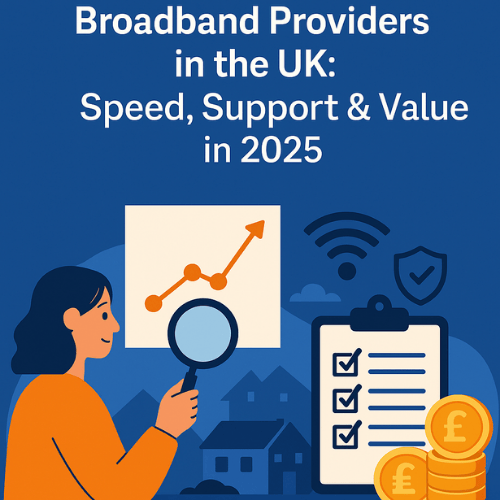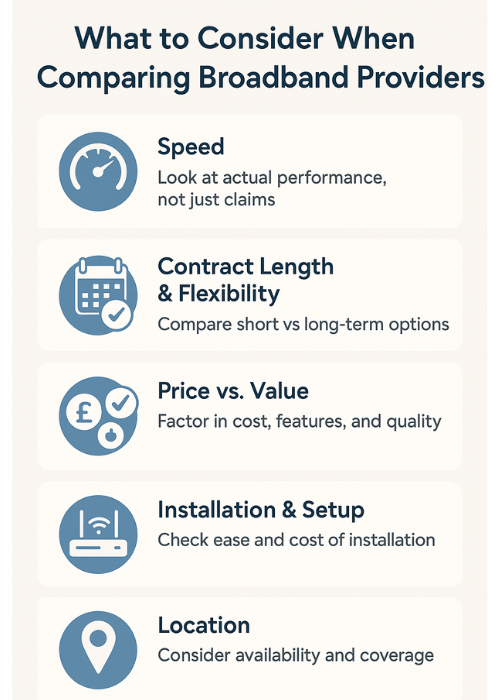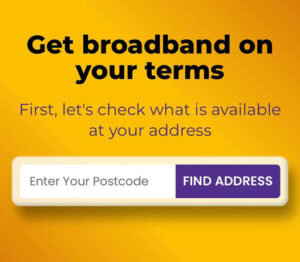How to Compare Broadband Providers in the UK: Speed, Support & Value in 2025

Let’s be honest…
Choosing a broadband provider in the UK can feel like navigating a maze — blindfolded.
Every provider promises “ultrafast speeds,” “award-winning service,” and “the best value.” But once you sign up, the reality often looks very different:
- Your connection drops during the final minutes of a live football match
- Customer support puts you on hold for 45 minutes
- You find hidden setup charges buried in the fine print
Sound familiar?
At Broadband Freedom, we’ve seen these stories far too often. And that’s why we created this no-nonsense, fully transparent guide — to help you compare UK broadband providers the way it should be done: based on real value, not marketing fluff.
Because here’s the truth:
In 2025, getting the right broadband isn’t just about saving money — it’s about peace of mind. Whether you’re working remotely, streaming in 4K, gaming online, or managing a household of connected devices, your provider should keep up with you — not the other way around.
So, in this ultimate guide, we’ll walk you through:
- How to properly compare UK broadband providers (and what most people overlook)
- Which providers offer the best speed, reliability, and support
- Who delivers true value (hint: it’s not always the cheapest deal)
- What to look for if you need flexibility, short-term contracts, or bundle savings
- How different providers perform by location, based on speed, coverage, and customer feedback
By the end, you’ll know which provider is right for your needs — and why.
Let’s get started
What to Consider When Comparing Broadband Providers

Before jumping into the speed charts and provider breakdowns, let’s zoom out for a second.
Too many people focus only on monthly price when choosing a broadband provider. And while price is important, it’s just one piece of the puzzle.
At Broadband Freedom, we believe the best broadband provider is the one that fits your lifestyle, location, and long-term needs — not just your wallet.
Here’s what to actually compare (and what most people miss):
1. Speed — But Not Just the Headline Figure
Providers love throwing around terms like “superfast” and “ultrafast” — but those labels can be misleading.
What matters more is:
- The average download and upload speeds customers actually get
- How consistent the connection is during peak hours
- Whether speeds are symmetrical (like with full fibre options)
For example, Hyperoptic and Community Fibre both offer 1Gbps full fibre speeds, but their average user experience can vary depending on the building and infrastructure.
Tip: Always check the estimated speed at your address — not just the advertised maximum.
2. Contract Length & Flexibility
Not everyone wants to be locked into a 24-month deal. That’s why we recommend comparing:
- Rolling broadband plans (like 1-month contracts)
- Short-term deals (6-month or 12-month options)
- Providers that offer no-contract broadband — ideal for renters or short-term stays
If flexibility matters to you, check out our Ultimate Guide to No Contract Broadband in the UK, where we break down all the best options.
3. Price vs. Value
Yes, price matters. But here’s the thing:
Some of the cheapest broadband deals come with:
- Hidden activation fees
- Poor customer service
- Sluggish speeds during busy hours
Instead, focus on value for money. Use our Compare Broadband Deals tool to filter by contract length, speed, and bonus perks like:
- Free gifts
- Wi-Fi boosters
- Unlimited data
- TV or mobile add-ons
You might be surprised which providers give the best bang for your buck.
4. Installation & Setup
Is the provider plug-and-play? Or does it require a multi-week wait for an engineer?
Some like BT Broadband offer free installation but with a contract lock-in. Others like italk or Cuckoo focus on quick activation and minimal setup hassle.
Need more detail? We’ve covered the whole process in our Broadband Installation Guide.
5. Location, Location, Location
This one’s big — broadband provider performance changes based on where you live.
For example:
- Virgin Media may offer top speeds in cities, but poor coverage in rural areas
- Gigaclear and Fibrus specialize in full-fibre rural rollouts
- Providers like Brsk are hyperlocal but offer blazing fast speeds in their zones
That’s why we built our Broadband Deals Near Me tool — to help you compare options by postcode, not just by brand.
6. Customer Service & Satisfaction
Speed is great — until something goes wrong.
Check:
- Trustpilot scores
- Ofcom complaint rankings
- Customer reviews (especially for installation and tech support)
We regularly review and update our provider pages, like:
So you can avoid the horror stories — and find the brands that treat customers like humans.
Speed & Performance Breakdown — Who’s Actually the Fastest in 2025?
Let’s cut through the hype.
Every broadband provider in the UK throws around the words “ultrafast,” “gigabit,” or “lightning quick.” But how fast is fast — really?
And more importantly: which broadband provider actually delivers those speeds to real customers in real homes?
In this section, we’re breaking down the truth about broadband speed in the UK in 2025 — from the tech types to the providers who truly stand out.
Understanding the Different Broadband Speeds
First, it’s important to understand that not all broadband is built the same. Here’s a quick rundown:
| Tech Type | Typical Download Speed | Upload Speed | Used By Providers Like |
|---|---|---|---|
| ADSL (Standard) | 10–20 Mbps | ~1 Mbps | Older BT lines, TalkTalk |
| Fibre to the Cabinet (FTTC) | 35–80 Mbps | 5–20 Mbps | Sky, Plusnet, italk |
| Fibre to the Premises (FTTP / Full Fibre) | 100–1000+ Mbps | 100–1000 Mbps | Community Fibre, Hyperoptic, Fibrus |
| 5G Home Broadband | 100–300+ Mbps | 50–100 Mbps | Three, Vodafone, EE |
Want to test your own speed? Use our Internet Speed Test Guide to benchmark your current provider.
Top UK Broadband Providers by Speed — 2025 Snapshot
Based on Ofcom-reported averages and real-world user feedback, here’s how major providers stack up in 2025:
| Provider | Advertised Speed | Real-World Speed (Avg.) | Speed Type |
|---|---|---|---|
| Hyperoptic | Up to 1Gbps symmetrical | 900+ Mbps down/up | Full Fibre |
| Community Fibre | Up to 3Gbps | 940–980 Mbps (1Gbps plan) | Full Fibre |
| Virgin Media | Up to 1.1Gbps | 600–800 Mbps | Fibre/Coax Hybrid |
| BT Full Fibre | Up to 900 Mbps | 500–700 Mbps | FTTP |
| Fibrus | Up to 1Gbps | 600–800 Mbps | Rural Full Fibre |
| Sky (FTTC) | Up to 80 Mbps | 50–70 Mbps | Fibre to the Cabinet |
| italk / TalkTalk | 38–67 Mbps | 30–60 Mbps | FTTC |
Explore provider-specific speed pages:
Speed vs. Reliability: What Most Providers Won’t Tell You
It’s easy to advertise a 900 Mbps speed. But what really matters is:
- Latency (ping) for gamers and video calls
- Packet loss (when your connection drops for a split second)
- Consistency during peak hours (6–10 PM)
Providers like Brsk and Hyperoptic often outperform the “bigger names” simply because their networks are less congested and better maintained.
Location-Based Performance Still Rules
If you’re in central Manchester, full-fibre speeds are almost guaranteed. But in more rural zones? Not so much.
That’s where local rollouts like Fibrus in Northern Ireland or Gigaclear in the countryside come into play.
To find the fastest provider near you, check our Broadband Deals Near Me tool — it’s postcode-specific.
Quick Takeaways
- Don’t choose based on advertised speeds — look for delivered performance
- Full fibre (FTTP) is the gold standard in 2025 — symmetrical, consistent, future-proof
- Smaller providers often outperform the big guys in speed and service
- Your postcode still plays a massive role in what’s available
Pricing & Value — Which Providers Actually Deliver on Cost vs Quality?
Let’s be real:
In 2025, broadband prices are all over the place. Some providers wave shiny £18/month deals in your face, but hit you with:
- £60 setup charges
- Price hikes after 6 months
- And “optional” extras that aren’t so optional
At Broadband Freedom, we believe the cheapest deal isn’t always the best deal — but the best deal should always feel like a steal.
So let’s break down what pricing really means in today’s broadband market.
Understanding the True Cost of a Broadband Deal
Before you compare providers based on monthly fees, factor in the full cost of ownership. That means:
- Setup/activation fees (some charge £30–£60 upfront)
- Router rental or purchase fees
- Out-of-contract price jumps
- Exit fees for early termination
- Bundle lock-ins (TV/mobile you didn’t ask for)
We’ve seen deals that advertise £19.99/month but cost over £500 a year once all extras are baked in.
That’s why we built tools like:
To help you compare the real cost — not just the headline.
Top Value Providers in 2025
Here’s a quick overview of which providers are delivering serious value right now:
| Provider | Typical Price (per month) | Includes | Value Notes |
|---|---|---|---|
| Cuckoo | £27–£29 | Unlimited data, rolling contract | Great for flexibility |
| Brsk | £25–£29 | Full fibre, symmetrical speeds | Excellent in areas it covers |
| BT Broadband | £28–£35 | Smart Hub 2, free install (12mo+) | Reliable but expensive |
| Sky Broadband | £27–£31 | TV bundles available | Watch out for contract lock-ins |
| Community Fibre | £22–£35 | 150 Mbps – 3 Gbps, free install | Best speed-per-£ ratio |
| italk | £21–£27 | 12-month options, good rural reach | Lower speed, but affordable |
Want tailored pricing based on your usage? Try our Broadband & TV Bundles – Compare & Save hub to filter by package type.
Look Out for Added Value (Not Just Discounts)
Many providers are stepping up their game by offering freebies or loyalty extras, such as:
- Amazon vouchers
- Free streaming subscriptions (Netflix, Disney+, Now TV)
- Free setup and delivery
- Wi-Fi booster kits
- Price-freeze guarantees
For example, Virgin Media regularly offers seasonal bundles with free tech gadgets, while BT sometimes includes a gift card or credit toward bills.
How to Avoid Common Price Traps
Let’s talk about the fine print — because this is where most people get burned.Price Trap #1: 6-Month “Intro Deals”
Sounds great — until month 7 hits and your bill jumps by 40%.
➡ Solution: Stick to 12-month pricing comparisons with a fixed monthly fee. Compare 18-Month Broadband Packages and 24-Month Deals to weigh long-term savings.
Price Trap #2: “Free” Add-ons That Raise the Base Price
Some providers bundle TV or mobile plans, then inflate your base broadband rate.
➡ Solution: Compare broadband-only deals first, then manually add bundles if you’ll use them. Start with our Broadband with Free Gifts hub.
Price Trap #3: Exit Fees on Short-Term Deals
No contract? Great. But miss the small clause that says: “30-day notice period applies”, and you’ll be charged for a whole month.
➡ Solution: Check our guide on No Contract Broadband — we break down which providers actually mean no-strings-attached.
Broadband Freedom’s Take: What “Good Value” Looks Like
We define a high-value broadband deal as one that:
- Offers at least 100 Mbps speed
- Costs under £30/month with no hidden fees
- Includes free installation or equipment
- Has short or flexible terms
- Maintains good support ratings
And as of 2025? Providers like Brsk, Community Fibre, and Cuckoo are leading the value charge.
Coverage Maps & Availability — Which Providers Actually Serve Your Area?
You’ve found a great deal. It’s fast, affordable and it is perfect.
Only one problem…
It’s not available where you live.
We’ve seen this happen too often — especially with full-fibre or budget broadband deals. Providers advertise UK-wide service, but when you enter your postcode? “Sorry, not currently available in your area.”
So let’s talk about coverage — who delivers, where, and how you can find out before wasting time.
How Broadband Coverage Works in the UK (in 2025)
There are three key infrastructure types in the UK:
- Openreach network (used by BT, Sky, TalkTalk, italk, Plusnet, etc.)
- Virgin Media’s cable/fibre hybrid network
- Independent full-fibre providers (like Community Fibre, Brsk, Hyperoptic, Fibrus, etc.)
While Openreach covers over 90% of the country, full-fibre is still rolling out — meaning postcode matters more than ever.
Major Providers & Where They Shine
| Provider | Strongest Coverage | Type |
|---|---|---|
| BT / Sky / TalkTalk | Nationwide (Openreach-based) | Fibre & FTTC |
| Virgin Media | Urban and suburban areas, over 55% of UK | Fibre-coax hybrid |
| Community Fibre | London (urban focus) | Full fibre |
| Hyperoptic | Apartment buildings in cities | Symmetrical full fibre |
| Fibrus | Northern Ireland, rural fibre | Rural FTTP |
| Brsk | North of England, Midlands (expanding) | Full fibre |
| Gigaclear | Rural southern England | Rural FTTP |
Looking for local deals? Our Broadband Deals Near Me page filters deals based on your postcode — not just your provider wishlist.
Don’t Just Trust the Provider’s Map
Most provider websites show coverage maps with vague shading like:
“Available in your area” — which often means “some postcodes nearby”, not yours specifically.
That’s why we recommend:
- Always using the provider’s postcode checker
- Comparing multiple providers with our Compare Broadband Deals tool
- Checking rural-focused ISPs like Fibrus or Gigaclear if you’re outside city centres
Spotlight: Manchester Case Study
We’ve launched several local coverage deep dives — and Manchester is a great example of overlap and competition.
In Manchester:
- Virgin Media offers full coverage with hybrid fibre
- BT/Sky dominate standard fibre packages
- Hyperoptic serves select apartment blocks
Brsk and Community Fibre are expanding fast
Want more regional snapshots? We’re rolling out new city-level deal maps every month.
What to Do If You’re Underserved
If your area lacks full-fibre or high-speed providers:
- Look into 5G home broadband (good for short-term or rural use)
- Choose a provider with fair usage caps and consistent FTTC speeds
- Register interest with FTTP providers — this often accelerates rollouts
Need help figuring out what you can get now? Visit our Broadband Comparison Page and sort by availability and contract type.
Final Thoughts — Finding the Right Broadband Provider for You
Let’s recap.
In 2025, comparing broadband providers in the UK isn’t just about finding the cheapest monthly fee or the fastest headline speed.
It’s about finding the right balance:
- The speed that keeps your home connected without buffering
- The contract terms that match your lifestyle
- The support that doesn’t vanish when you need it most
- And yes — pricing that’s honest, transparent, and delivers true value
At Broadband Freedom, we’ve spent years breaking down broadband jargon, calling out bad deals, and helping UK households find internet that actually works for them — not just on paper, but in everyday life.
So, what’s your next step?
Here’s what we recommend:
Ready to Switch or Compare?
Use these tools to take action now:
- Compare Broadband Deals: Filter by speed, contract, and postcode
- Broadband Providers Overview: Learn the pros and cons of every major ISP
- Broadband Deals Near Me: See what’s actually available where you live
- Broadband with Free Gifts: Don’t miss out on the latest bundle offers
Still Not Sure?
We get it — broadband isn’t one-size-fits-all. If you’re still unsure what’s best for your home, explore our deep-dive guides:
- No Contract Broadband – The Ultimate 2025 Guide
- 1-Month vs 12-Month Contracts: What’s the Real Cost?
- Broadband Installation in the UK: What to Expect
Or reach out to us directly — we’re here to help.
Your Freedom Starts With the Right Connection
Whether you’re a student, a remote worker, a gamer, or just someone tired of poor service, remember this:
You deserve better broadband.
Faster. Fairer. Simpler. More transparent.
And we’re here to make sure you get it.



